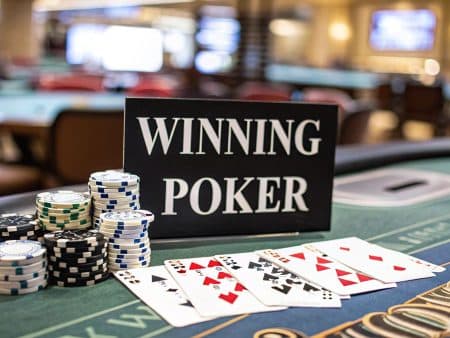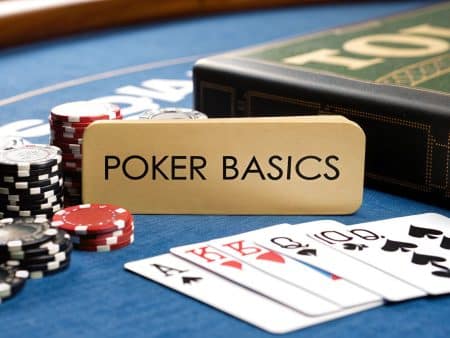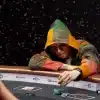Knowing how to bluff in poker is about more than just blind aggression. It's about telling a believable story with your bets, picking your spots carefully, and targeting the right opponents. The goal is simple: take a calculated risk to make a player holding a better hand fold. Your success hinges entirely on one thing—convincing the table your hand is stronger than it actually is.
The Art of the Bluff: A Crucial Poker Skill

Let's be clear: bluffing is a non-negotiable skill for any serious poker player. If you don't have it in your arsenal, you're a sitting duck.
Think about it. If you only bet when you have a monster hand, observant opponents will pick up on that pattern in a heartbeat. The moment you show aggression, they'll all fold, and you'll get zero value for your premium hands.
Weaving bluffs into your game keeps everyone at the table guessing. It builds a dynamic, unpredictable table image that forces your opponents into tough, uncomfortable spots. When they know you’re fully capable of firing a big bet with nothing, they're far more likely to pay you off when you finally wake up with the nuts.
Before you start bluffing, it's critical to understand the foundation of a believable play. The following table breaks down the three core components that must align for your bluff to have the best chance of succeeding.
Three Core Pillars of a Successful Bluff
| Pillar | Key Consideration | Why It Matters |
|---|---|---|
| The Story | Does your betting line make sense? | Your actions from pre-flop to the river must tell a consistent, believable story. A random, out-of-place bet screams "bluff." |
| The Opponent | Who are you trying to bluff? | Targeting a loose "calling station" is a losing play. You need to pick opponents who are capable of folding a decent hand. |
| The Situation | What does the board look like? | A scary, coordinated board with flush and straight draws is easier to represent than a dry, disconnected one. Your bluff needs to fit the board texture. |
Getting these three elements to work in harmony is what turns a hopeful punt into a profitable, well-executed bluff.
The Math Behind Deception
Bluffing isn't just about feel or guts—it’s grounded in solid game theory. Mathematical models actually help us figure out the optimal frequency for bluffing to keep our opponents from exploiting us.
For instance, in a simplified two-player scenario, a player’s ideal bluffing frequency is around 33%. This specific frequency is designed to make your opponent completely indifferent to either calling or folding, which is the hallmark of a balanced, tough-to-play-against strategy.
At its core, bluffing is about controlling the narrative of the hand. You're not just playing your cards; you're playing your opponent's perception of your cards.
The Psychological Edge
Beyond the numbers, bluffing is a potent psychological weapon. A well-timed bluff puts immense pressure on your opponents, forcing them to second-guess their reads and potentially make huge mistakes.
This is the mental warfare that separates good players from great ones. It allows you to steer the game and manipulate situations to your advantage. For a deeper look into this side of the game, check out our insights on the psychology of bluffing.
Pulling off one key bluff can completely shift the table dynamic in your favor for hours to come.
When to Pull the Trigger on a Poker Bluff

Anyone can just toss chips into the pot and hope for the best. That’s not bluffing; that’s gambling. True bluffing is an art, and the most important part of that art is timing. A poorly timed bluff is literally just giving money away. To pull one off successfully, you need to see a few key factors line up just right, and you have to make that read in a matter of seconds.
First thing's first: how many people are in the hand? If you're trying to bluff a table with three or more other players, you might as well just set your money on fire. The math is simple—the more players, the higher the odds that somebody, somewhere, actually has a hand they’re willing to go to war with.
The sweet spot for a bluff is a heads-up pot. When it's just you and one other player, your job becomes infinitely easier. You only have to convince one person that you've got the goods.
Your Position Is Your Power
In poker, your position at the table is everything. It's your most powerful weapon. Trying to bluff from an early position, when you’re one of the first to act, is a huge gamble. You’re betting in the dark with no clue what the players behind you are going to do. Nothing feels worse than firing out a bluff only to have someone behind you re-raise with the nuts.
The best time to bluff is when you're in late position, like on the button or cutoff. This is prime real estate. You’ve had a chance to watch everyone else act. Did they all check? That’s a massive sign of weakness and a green light to take a stab at the pot.
The later your position, the more information you have. More information leads to better decisions, and bluffing is all about making an informed, calculated decision.
Information is the currency of poker, and sitting in late position makes you the richest player at the table.
Reading the Board Texture
The community cards—the board—tell a story. For your bluff to be believable, it has to fit that story. A successful bluff represents a strong hand that actually makes sense with the cards on the table.
Think about it in these terms:
- Dry, Uncoordinated Boards: Imagine a flop like K♠ 7♦ 2♣. This is what we call a "dry" board. There are no flush draws, no obvious straight draws. If you raised before the flop, a continuation bet here is incredibly powerful. It screams that you hit that King, and it’s very unlikely your opponents connected with these cards.
- Wet, Coordinated Boards: Now picture a flop like J♥ 10♥ 8♠. This board is "wet" and "draw-heavy," a minefield of potential straights and flushes. Bluffing here is incredibly risky. Your opponent could easily be sitting on a monster draw they have no intention of folding. You could be running straight into a brick wall.
Before you even think about bluffing, ask yourself one critical question: "What hand am I trying to represent, and does the story make sense?"
Knowing when the board gives you an opportunity is key, but so is getting a read on your opponent. Learning to pick up on their tells can give you the extra confidence you need to make your move. For more on that, check out our guide on poker tell recognition and the subtle signs your opponent is bluffing.
Picking Your Spot: From C-Bets to All-In Shoves
Not every bluff is a Hollywood-style, all-in shove on the river. In fact, most aren't. Knowing which type of bluff to use—and when—is what turns a reckless gamble into a calculated, profitable play. Think of it like a toolbox; you wouldn't use a sledgehammer to tighten a small screw.
The right bluff for the job depends entirely on the context. Who are you playing against? What does the board look like? What story have you been telling with your betting so far? Let's get into the three main types of bluffs you'll be running.
The C-Bet: Your Go-To Bluff
The Continuation Bet, or c-bet, is the most common bluff in poker, and for good reason. It's your bread and butter. The play is simple: you raised before the flop, and now you're betting again on the flop, whether you hit it or not.
By raising pre-flop, you already told the table you have a strong hand. Betting again continues that story. It’s a natural, aggressive line that puts immediate pressure on your opponent.
Say you raise with A♦ K♠ and one player calls. The flop comes down J♣ 7♥ 2♠. You missed completely. But a standard c-bet here is perfect. That’s a very dry board, making it unlikely your opponent hit it either. Your bet is often enough to take down the pot right there with very little risk.
The Semi-Bluff: Bluffing With a Backup Plan
This is where things get more interesting. A semi-bluff isn't just a bet into the darkness; it's a bet with a hand that has a real chance to become the best hand later. You’re betting with a draw—a flush draw, a straight draw, or maybe even just a couple of overcards.
This clever move gives you two ways to win the pot:
- Your opponent folds right away. Mission accomplished.
- Your opponent calls, but you hit your hand on the turn or river. You win a much bigger pot because they paid you off.
Imagine you’re holding 8♥ 7♥ on a K♥ 6♣ 2♥ flop. You have nothing but a flush draw, but betting here is a powerful semi-bluff. You could easily get a hand like A♠ Q♦ to fold. But even if they call, any heart on the turn or river gives you the nuts. The semi-bluff is an aggressive play with a built-in safety net.
The Stone-Cold Bluff: The All-Or-Nothing Play
This is the one you see in the movies—the big, bold shove on the river with absolutely nothing. A stone-cold bluff is a pure bluff with a hand that has zero showdown value. You win if they fold. You lose if they call. Period.
This isn't a move you make lightly. It's a high-risk, high-reward play that requires the perfect situation. Your story throughout the hand has to be flawless, perfectly representing the monster hand you’re pretending to have. The timing, your opponent, and the board all have to line up.

As the data shows, pulling off a bluff becomes more effective on later streets. The river is where the pressure is at its peak, and a well-told story can force folds from decent hands. If you want to get truly comfortable in these spots, you have to keep refining poker bluff strategies and learning how to read the game flow.
Bluff Type Comparison When to Use Each
To make it even clearer, think of these bluffs as different tools for different jobs. This table should help you quickly decide which weapon to pull out of your arsenal based on the situation you're facing at the table.
| Bluff Type | Ideal Situation | Hand Strength | Risk Level |
|---|---|---|---|
| Continuation Bet | As the pre-flop aggressor on a dry, uncoordinated flop. | No Made Hand | Low |
| Semi-Bluff | You have a drawing hand (flush/straight draw) on the flop or turn. | Drawing Hand | Medium |
| Stone-Cold Bluff | The board and betting story perfectly align to represent a monster hand. | No Showdown Value | High |
Knowing when to fire a simple c-bet versus when to pull the trigger on a semi-bluff or a pure bluff is what separates good players from great ones. Mastering all three will make you a much more unpredictable and dangerous opponent.
Sizing Your Bets to Tell a Convincing Story

At the poker table, your bet size does most of the talking. A clumsy, weak-looking bet screams "bluff!" just as loudly as any physical tell. On the flip side, a confident, well-sized bet can convince an opponent to muck a genuinely strong hand.
Think of bet sizing as the punctuation at the end of the story you're telling. Get it wrong, and the entire narrative collapses. A small, tentative bet often looks like a cheap stab at the pot, practically inviting a call from anyone with a sliver of a hand. It projects fear, not strength.
To put maximum pressure on your opponent, your bluff has to look and feel like a real value bet. This usually means betting somewhere between two-thirds of the pot and a full pot-sized bet. This kind of sizing forces your opponent into a truly difficult decision for a meaningful chunk of their chips.
Sizing Based on Board Texture
The community cards on the board are everything. Your bet has to make sense within the context of the possible hands and draws out there.
Let's look at two different situations:
- Dry Board (e.g., K♦ 8♣ 3♠): When there are no obvious flush or straight draws, a smaller bet—maybe around half the pot—can get the job done. It tells a simple, believable story: you hit the King and are betting for value.
- Wet Board (e.g., Q♥ J♥ 7♣): On a board littered with draws, you need to bet bigger. A larger bet, like three-quarters of the pot or more, is crucial. You have to make it mathematically wrong for your opponents to chase their flush or straight draws.
A powerful bluff is sized to make your opponent's decision as painful and expensive as possible. Your goal is to price them out, making folding the only logical choice.
Adjusting to Your Opponent
Of course, you can't just bet the board; you have to bet the player. A tight, cautious opponent might fold to a half-pot bet, but a loose "calling station" might shrug and call a pot-sized bet with a weak pair.
Pay attention to how different players react to different bet sizes. If you spot someone who consistently folds to big bets on the turn, you've found a weakness you can exploit later with a perfectly timed, well-sized bluff. Remember, you're not just playing your cards—you're playing your opponent's tendencies and their perception of what your bets mean.
Ultimately, you’re trying to tell a story that represents a monster hand. This is why it’s so important to have the fundamentals down cold, like knowing the poker hand rankings from royal flush to high card. Your bluff must logically represent one of those hands at the top of the chart.
Finding the Right Targets for Your Bluffs
Knowing how to bluff is only half the battle. A perfectly timed, well-sized bluff fired at the wrong player is the poker equivalent of running head-first into a brick wall. All your clever strategy means nothing if the person you're targeting simply isn't capable of folding.
This is why opponent profiling is one of the most critical skills in your bluffing arsenal. Your primary mission is to figure out who at the table you can push around and who you need to avoid.
Know Your Opponent: The Two Key Player Types
At any given table, you’ll find a mix of players, but for bluffing purposes, you can group most of them into two major categories. Learning to spot them will tell you exactly who to attack and who to steer clear of.
The first type is the player you should almost never bluff: the "calling station." These players are notoriously curious, often stubborn, and seem to hate the fold button. They’ll call you down with bottom pair, ace-high, or any piece of the board just to “keep you honest.” Trying to bluff them is one of the fastest ways to torch your chip stack. They aren't trying to out-think you; they just want to see the showdown.
Your ideal target is the complete opposite: the "tight, thinking player." This is someone who understands the game, plays logically, and can be forced to fold a decent hand when faced with credible aggression. They are constantly trying to piece together the story your bets are telling, which means a believable bluff can work wonders against them.
The golden rule of bluffing is simple: Bluff players who can fold. Value bet players who can't. Targeting the right opponent is often more important than the actual cards you're holding.
So, how do you tell them apart in the wild? You have to watch their actions like a hawk.
- Calling Stations tend to limp into a lot of pots, call raises with all sorts of marginal hands, and rarely raise unless they have the stone-cold nuts. You'll see them get to a ton of showdowns with surprisingly weak holdings.
- Thinking Players are much more selective with their starting hands. They play more aggressively, especially from a late position, and aren't afraid to fold to significant pressure on the turn or river if the board gets scary and your story makes sense.
Live vs. Online: Adapting Your Reads
The way you read players changes completely when you move from a live table to your laptop. In a live game, you have a wealth of information at your fingertips. You can look for physical tells—nervous tics, how they handle their chips, their eye contact—to help build a profile.
But online, all those physical cues vanish. You have to become a different kind of detective, one who relies entirely on betting patterns and data.
When playing online, keep a close eye on:
- Bet Sizing: Does an opponent always bet small with weak hands and over-bet their monsters? Many players have predictable sizing tells.
- Timing Tells: Do they snap-bet when they have it but take forever when they're on the fence? Instant actions can be a huge giveaway.
- Showdown History: When they do call a big bet, what are they turning over? This is the most reliable piece of information you can get.
This gets especially tricky in anonymous online games, where you have no player history to draw from. The lack of visual cues and historical data makes it incredibly difficult to run an exploitative play like a bluff. In fact, some pros estimate that only about 1% of players can consistently win at anonymous tables because the very tools needed for effective bluffing are taken away.
If you want to dig deeper into how anonymity changes the game, it’s a fascinating subject. Mastering these digital tells is absolutely essential if you want to know how to bluff in poker when you can't even see your opponent's face.
Answering Your Biggest Questions About Bluffing
Even when you know the basics, a little voice of doubt can creep in when you're thinking about pulling the trigger on a big bluff. It's totally normal. Let's clear up some of the most common questions players have so you can play with more confidence.
How Often Should I Be Bluffing?
This is the million-dollar question, and the answer is almost always "less than you think." There’s no perfect percentage. While a GTO wizard might have a precise frequency, real-world poker is about adjusting to the people you're playing against.
If you’ve spotted a player who seems to fold at the first sign of trouble, you can absolutely dial up the aggression and bluff them more often. On the flip side, if you're up against a "calling station"—that one player who just has to see what you've got—you should practically take bluffing out of your playbook against them.
The real goal is to keep everyone guessing. You want to mix in just enough bluffs that your opponents are never 100% sure whether you're holding the nuts or a fistful of air. That doubt is where you make your money.
What’s the Biggest Bluffing Mistake New Players Make?
Hands down, the most common and expensive mistake is bluffing without telling a believable story. Firing a random, massive bet on the river after passively checking the flop and turn just doesn't add up. To anyone paying attention, that move practically screams, "I missed my draw and I'm desperate!"
A good bluff is the climax of a story you’ve been building on every street.
Before you even think about pushing those chips in, ask yourself: "What specific hand am I representing, and does every action I've taken so far back up that story?" If there are plot holes, your bluff is probably going to get a bad review.
Telling a convincing story means you need a solid feel for hand strength and the board. Brushing up on some poker math made simple will make your bluffs way more believable.
What Do I Do When My Bluff Gets Called?
First, take a breath. Do not tilt. Getting a bluff picked off happens. It happens to recreational players, and it happens to the best pros on TV. It's just part of the game. Instead of getting mad, see it for what it is: a piece of valuable information.
Take a second to think about what happened:
- Did you pick the wrong target? Trying to bluff someone who never folds is just lighting money on fire.
- Was your bet sizing weird? A bet that was too small might have given your opponent irresistible odds to look you up.
- Was your story weak? Maybe your pre-flop raise didn't align with the monster hand you were trying to represent on the river.
Sometimes, your opponent just woke up with a monster, and there was nothing you could have done. But here's the silver lining: a failed bluff actually helps your image. Now, the whole table has seen you're capable of getting out of line. The next time you actually have a monster hand, they'll be that much more likely to pay you off.
At PokerSites.org, we're dedicated to helping you become a more formidable player. Whether you're a beginner learning the ropes or an experienced player refining your strategy, find everything you need at https://www.pokersites.org.
Article created using Outrank













